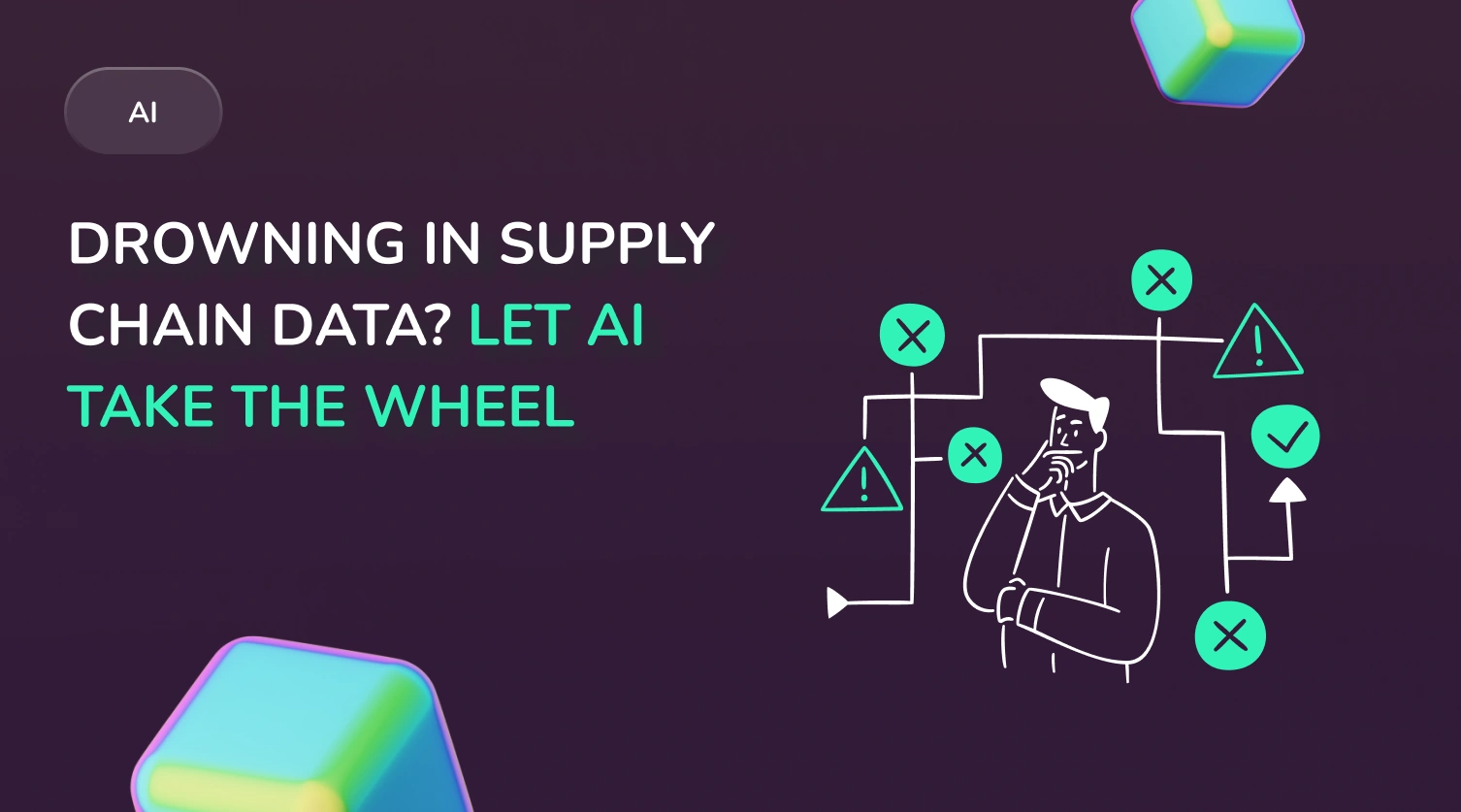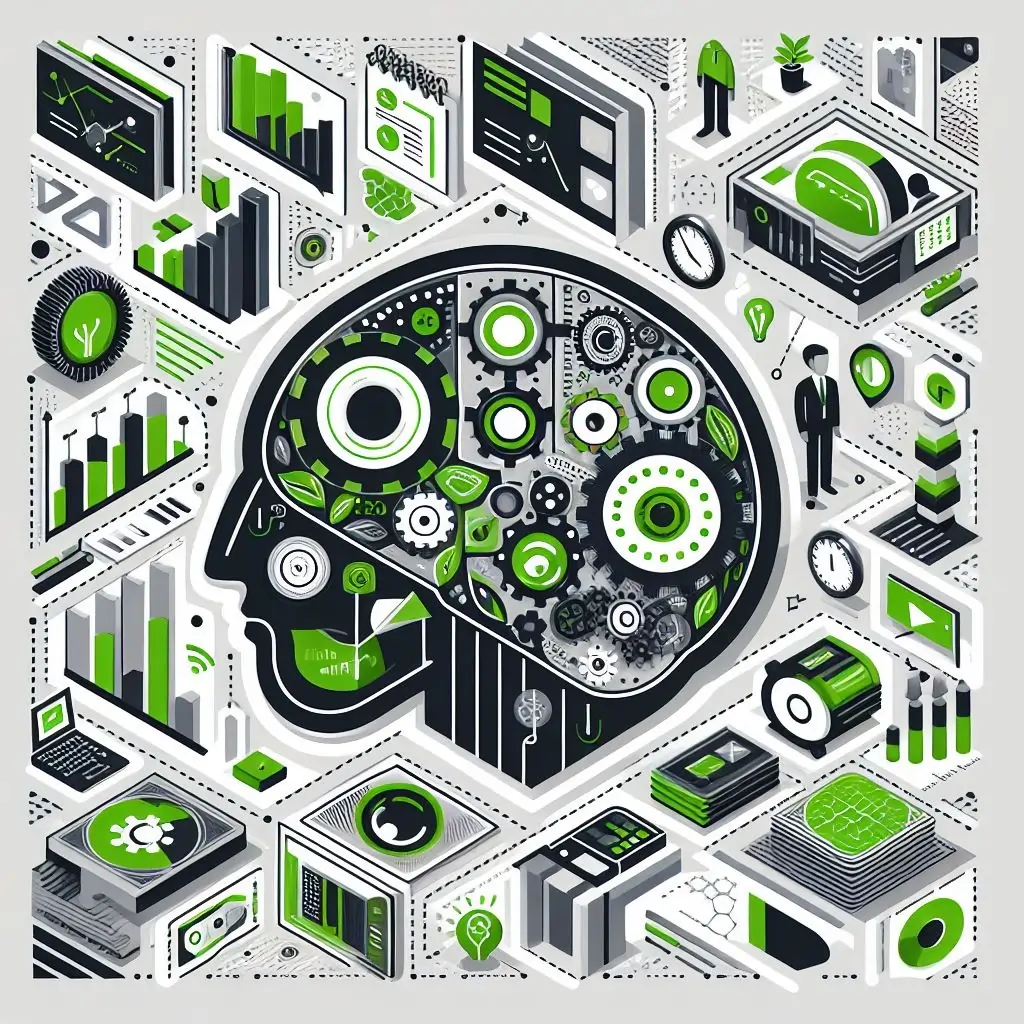
From Chaos to Control Through Data
In our previous article, we examined how supply chain cost optimization enables businesses to transition from chaos to control. But as many entrepreneurs know, once you’ve sorted out the finances, a new challenge always comes knocking: data.
The volume of data continues to grow from ERP, CRM, warehouse systems, IoT sensors, GPS trackers, and external vendors. Trying to handle this manually quickly becomes overwhelming. That’s why we recommend a solution that not only processes data but also adapts to the evolving needs of your business, scalable AI.
What Is Scalable AI and Why Do You Need It?
Let’s be honest, when your business starts scaling, things get messy. More orders, more vendors, more delivery points, more moving pieces, and everything in real-time. Many business leaders find themselves in a situation where they’ve already invested in automation, but still feel like they’re constantly putting out fires. Systems give you reports, not decisions. Every new supplier or warehouse feels like another weight pulling the chain tighter.
And here comes the familiar question: How do you manage it all without overloading your team or breaking your systems?
This is where scaling AI comes in. It’s not just an intelligent assistant, it’s a full-fledged infrastructure that grows with your business. Unlike traditional one-off solutions, scalable AI doesn’t break when you expand. Add more suppliers, launch a new warehouse, expand your product line, and the system adapts. No major overhauls needed. It learns, adjusts, and continues to offer insights as complexity increases.
Let’s put this into a real-world example.
Suppose you currently work with five suppliers across several regions. Six months later, you’re dealing with thirty. A basic system would likely collapse under the pressure, unable to keep up with new routes, delivery windows, or regional specifics. A scalable AI solution, however, is designed to handle growth. It leverages cloud computing, distributed architecture, and continuous learning to maintain accuracy, regardless of the number of new data points introduced, without slowing down or requiring reconfiguration.
If you feel your business has outgrown “managing by gut,” it’s probably time to explore AI-powered scalability. You need a system that gets smarter and more useful the more you rely on it, not one that holds you back when you’re trying to move forward.
How Scalable AI Simplifies Supply Chain Data Management
If you’ve ever been responsible for managing a supply chain, you’ve likely seen how smoothly everything runs… until one small thing throws it off. A delayed shipment, bad weather, a supplier issue, an unexpected traffic jam, a last-minute order cancellation, and suddenly the whole chain begins to unravel. The challenge isn’t always to scale its interconnected complexity. Every event triggers a ripple effect, and the more moving parts you have, the harder it becomes to stay on top of everything especially when your data is scattered, some in ERP, some in email threads, some just in someone’s head.
This is precisely where the true power of scalable AI becomes evident. Instead of struggling to track dozens of variables manually, AI scale solutions collect and analyze all your operational data from internal systems, such as ERP, TMS, and WMS, as well as external sources, including IoT sensors on vehicles, GPS tracking, and live weather updates.
However, unlike traditional systems that generate static reports after the fact, AI scalability enables real-time work. It detects patterns, flags disruptions before they escalate, and even suggests optimal responses automatically. You’re not just reacting faster, you’re making better decisions earlier.
For example, if there’s a recurring delay every Friday from a supplier in a particular region, a scalable AI model will notice the pattern, identify the cause (traffic congestion, limited dock availability, etc.), and recommend changing your delivery window or adjusting your inventory strategy all without anyone needing to dig through spreadsheets or reports.
In short, scaling AI turns chaotic data into coordinated action.
And the best part?
As your business grows and generates more data, the system becomes increasingly effective at predicting and preventing disruptions without adding complexity for your team. That’s the essence of AI-powered scalability in the supply chain: smarter decisions, less firefighting.
So How Does It Work in Practice?
Let’s take a real example. A consumer goods distributor noticed a recurring issue: every Friday after 3 p.m., shipments coming from Eastern Europe were consistently delayed. Their team was constantly in “firefighting mode” manually rescheduling orders, rerouting deliveries, and trying to smooth things out at the last minute.
After implementing a scalable AI model, everything changed. The system started automatically analyzing delivery schedules, traffic congestion data, weather forecasts, and factory production calendars not once a week, but continuously. Without anyone needing to manually interfere, the AI recognized the Friday pattern and recommended shifting shipments to Thursday mornings to avoid the usual delays.
And it didn’t just make that call once. It did so consistently, monitoring, learning, and adapting without extra input from the team.
This is the power of AI-powered scalability in action. It acts as your analyst, logistics coordinator, and decision-support system, all in one, only faster, sharper, and always on. As your business grows, you’ll have more suppliers, more SKUs, and more delivery zones, all of which scale with you. No need to rebuild systems or re-train teams.
That’s the core value of scaling AI. Instead of your operations slowing down under growing complexity and data overload, your business becomes more agile and easier to manage with better outcomes and fewer surprises.
Where Is This Already Working and What Proves It?
If you’re still thinking that scalable AI is some futuristic concept suited only for tech giants, think again. Across industries and markets, companies are already leveraging AI-powered scalability to address practical problems, from demand forecasting to transportation and warehouse optimization, and they’re seeing real, measurable results. Here are just a few real-world examples illustrating what scaling AI can achieve.
Mars + Celonis
By implementing a scalable AI system to analyze supply chain processes, Mars reduced manual operations by 80%. This not only sped up key logistics workflows but also allowed the company to optimize routing and significantly reduce CO₂ emissions, aligning with its broader sustainability goals. Notably, these improvements were achieved without expanding the team or overhauling the infrastructure.
Danone
This global FMCG leader turned to scalable predictive analytics to respond to highly variable local market demand. The outcomes:
- 20% fewer forecasting errors,
- 30% fewer losses from stockouts,
- Better inventory turnover across distribution centers.
That’s crucial in sectors with short product lifecycles, where even a small forecasting error can result in both financial loss and product waste.
European Retail Chain
A supermarket chain with over 100 stores implemented an AI platform to optimize logistics operations. The impact was substantial:
- €3.5 million saved annually,
- 33% lower logistics costs,
- 90% on-time in-full (OTIF) delivery rate.
All this was achieved without a large internal IT team. The key to success was selecting exemplary architecture and collaborating with an experienced AI integration partner to scale a pilot into a full rollout rapidly.
Each of these companies had different starting points. Still, the lesson remains the same: scalable AI helped them adapt more quickly, reduce costs, and enhance service levels, even in volatile environments. It’s like switching from an old paper map to a live GPS one that doesn’t just show the way, but constantly adjusts in real-time to keep you ahead of delays, risks, and inefficiencies.
From Automation to Operational Efficiency
It’s essential to draw a clear line: scalable AI isn’t just about automating routine tasks. It’s about optimizing decisions across the entire supply chain, uncovering weak spots before they cause trouble, and adapting in real time to both internal and external changes.
Instead of spending hours compiling reports and chasing numbers, AI gives decision-makers actionable insights like:
“Reroute shipments to Hub C,” or “Adjust demand forecast for Region Y based on early signals.”
This shift from reactive to proactive management is what transforms basic automation into actual operational efficiency, especially when you’re working with a complex and fast-growing network of suppliers, distribution channels, and customers.
What Scalable AI Architecture Looks Like
AI architecture may sound like a topic for IT teams, but let’s simplify. A scalable AI system is essentially a flexible, adaptive infrastructure designed to grow with your business, without requiring constant rework or technical overhauls. Here’s what it typically includes:
Cloud-Based Platform
No need to invest in expensive servers or overbuild your infrastructure. Everything runs in the cloud. That means you only pay for what you use, and as your operations expand, the system scales resources automatically. There’s no need to stop processes or refactor code; AI scaling happens seamlessly.
API Integrations
You already rely on different tools, CRM, ERP, warehouse systems, and BI dashboards. Scalable AI doesn’t replace them; it connects to them via APIs and works with what you already have. That makes it a smart option for companies that want results quickly without having to rebuild everything from scratch.
Continuous Learning (MLOps)
Once the AI model is deployed, it continues to learn. If demand patterns shift, new partners join the supply chain, or seasonal trends emerge, the model re-trains itself and automatically adjusts its recommendations. Thanks to MLOps, the system stays relevant and practical without manual updates or disruptions.
💡 Now imagine this
It’s December, and your order volume doubles; you bring a new warehouse online to handle the increased load. A traditional system might crash or struggle to keep up. However, with AI scalability, the system automatically balances the load, updates forecasts, and reroutes logistics without interruption. That’s the architectural advantage: you grow, and your system grows with you, with no rebuilds required.
This is the essence of AI-powered scalability: smart infrastructure that adapts, scales, and stays ahead of the curve while making your business faster, more efficient, and better prepared for whatever comes next.
Step-by-Step AI Implementation. How It Works in Practice
Thinking about implementing scalable AI, but not sure where to begin? The good news is you don’t have to disrupt your operations or take big risks to get started. This isn’t one of those “rip everything out and rebuild” projects. Instead, think of it more like a smart test drive with a clear path for growth. Here’s how the process works in the real world:
Step 1. Identify the Core Business Challenge
Don’t start with the tech, start with the pain. Where are you losing the most money, time, or efficiency? It’s often due to overstocking, late deliveries, or underutilized transport. Choose one area where even a slight improvement could make a big impact. That’s your entry point for scaling AI.
Step 2. Prepare Your Data
AI doesn’t work in the dark. It learns from your business data, orders, shipments, inventory, and fulfillment cycles. And here’s where many companies stumble: their data is scattered, inconsistent, or duplicated across systems. Preparing clean, structured, and usable data accounts for approximately 60% of project success. At this stage, it’s advisable to bring in a partner experienced in data preparation and integration, someone who has done this before.
Step 3. Launch a Pilot Project (PoC)
Don’t roll it out company-wide just yet. Start small to test your AI-powered scalability with a specific warehouse, product category, or region. This provides clarity on how the model performs, the accuracy of the forecasts, the speed at which the system processes inputs, and the user-friendliness of the system.
Step 4. Measure the Results
The goal isn’t just to “run AI” it’s to see real business outcomes. For example:
- Lower inventory surplus,
- More accurate procurement planning,
- Higher on-time delivery rates,
- Less time wasted on manual reporting or coordination.
These are clear, measurable wins that justify scaling further.
Step 5. Scale the Solution
If the pilot shows strong results, expand gradually. Add new regions, product lines, and transportation routes. The significant advantage here is that by this point, you know what resources are needed and how to avoid friction. This is where AI scaling starts to prove its value.
Step 6. Automate Learning with MLOps
After launch, the model shouldn’t just sit there; it needs to keep learning. That’s where MLOps comes in. These processes allow your AI to update itself as conditions change, new suppliers, shifting demand, seasonal peaks, or supply chain disruptions. No manual reconfiguration needed.
Why Involving Professionals Matters
AI is everywhere right now in headlines, on conference stages, and in boardroom discussions. And it’s no surprise that many companies are eager to jump in and start using it. But there’s one thing business leaders need to understand: implementing scalable AI isn’t like installing new software or buying an analytics subscription. It’s a strategic architecture project, and getting it wrong at the start can lead to significant setbacks later, especially if you’re doing it without prior experience.
One of the most common reasons AI initiatives stall is at the data preparation stage. A company might think they’re ready: they have CRM, ERP, and warehouse tools in place. However, in reality, the data is often messy, duplicated, outdated, stored in silos, or kept in Excel files on local drives. Without clean, structured data, the model either fails to train or gives unreliable results. That’s when frustration kicks in and the ROI disappears.
Another pitfall?
The architecture itself. A truly scalable AI solution must be flexible, capable of connecting to your systems via APIs, leveraging cloud infrastructure, and continuously learning through MLOps. If these essentials are missed in the design, you may end up with something that works “for now,” but falls apart the moment your business grows.
That’s why more mid-sized and enterprise-level companies are choosing to work with external AI teams, not because they can’t do it internally, but because they want to do it faster, cleaner, and with fewer risks.
What does working with the right AI partner give you?
✅ Pilot launched in 4–6 weeks, not six months;
✅ Stable architecture that doesn’t require fixing when you scale up;
✅ A model tailored to your actual business challenge, not just “something smart that looks good”;
✅ Risk reduction is especially critical if you’re starting from zero and want results, not experiments.
If you want AI to be a real business asset, not just a checkbox for innovation, trust its implementation to people who know how to bridge cutting-edge tech with real-world business needs. That’s the difference between experimenting and scaling.
Wrapping up
Today, data isn’t just a byproduct of operations; it’s the fuel for better, faster, and more thoughtful decision-making. In this reality, scalable AI is no longer just a helpful tool, it’s a strategic business asset. With the proper setup, scalable AI helps you:
- Turn data into decisions, not just dashboards;
- Anticipate disruptions before they happen;
Stay ahead, even when the market is unpredictable and volatile.
If you’re still managing your supply chain manually, constantly reacting to problems, juggling spreadsheets, and firefighting delays, it’s time to try a more innovative approach. AI-powered scalability enables you to manage complexity with confidence and continue growing without being overwhelmed by data chaos.
And the safest, most effective way to start?
Collaborate with a professional team that understands how to tailor AI architecture to your unique business requirements. Whether you’re testing a pilot or planning full-scale deployment, the right partner will help you move fast without breaking what already works.
Subscribe to our blog


